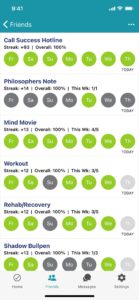The coaching profession can be frustrating.
Especially when put forth so much time and effort practicing, preparing—only to fall short of your goal by something totally outside of your control.
Many of us [coaches] have clients that want to get to the next level. You know that in order for them to accomplish that goal they‘ll need to break some bad habits and create good habits.
I’m sure a few of your own athletes come to mind and the exact habits they need to create or break.
If you are struggling to get them to break the bad habits that are holding them back and create the success habits that they need to take them to the next level, then read on.
Hint: it’s a simple framework backed by science.
I want to share it with you because I know it works.
I’ve been doing this for over two decades and it’s the same framework that I use with my clients to create good habits and break bad ones.
In order to do that you must understand how behavior design works.
3 Important Concepts:
- Behavior design follows a process. It has a trigger, the behavior (voluntary or involuntary), and the reward.
- Behaviors (positive or negative) have a compounding effect.
- Habits can be learned and unlearned—accountability and coaching are crucial in breaking bad habits and creating good ones.
Behavior Design Process:
Behavior design has been studied and written about by researchers like Charles Duhigg (The Power of Habits), BJ Fogg (Tiny Habits), and James Clear (Atomic Habits).
They all reference one key concept (the process of behavior design).
Trigger: something happens and then emotion arises. (stress for example)
Behavior: we do something—either the behavior we want more of (the good habit) or the behavior that we want to break (the bad habit)
Reward: the feeling we get after the behavior—usually empowerment or numbing. Either way, that first emotion is replaced (rewarded)
Real Life Example
So let’s talk about a very common habit that your clients might have.
It’s one that I had for a long time when I was 240 pounds with a 44 inch waist [60 pounds heavier than I am today]…
I am up late watching TV. Just as I get up to go to bed I feel my stomach growling—reminding me that I haven’t eaten anything in several hours.
So what do I do?
I walk to the kitchen and begin scanning the pantry for something quick and easy.
My eyes land on the bag of Doritos (my favorite)—I tear open the bag and start eating.
Pause for a moment and identify each component of the behavior design process.
Trigger: stomach growling
Behavior/Routine: I walk to the pantry to find something quick and easy—then smash a bag of Doritos
Reward: I am no longer hungry (and I love Doritos)
Now this obviously was a bad habit preventing me from losing weight. Late night snacking on Doritos did not align with my weight loss goals.
The first step is to recognize what the trigger is and bring awareness to what this habitually makes us do (behavior or routine).
Now that we have awareness we can make a change.
Let’s keep the same trigger (late night hunger), but let’s change the behavior.
Buy your discipline at the grocery store—meaning don’t bring the Doritos home—buy vegetables instead.
I like carrots and bell peppers. So instead of going to the pantry for Doritos when my stomach starts growling, I go to the refrigerator for the pre-cut veggies.
I sit down and eat just like I would with the Doritos, and the reward is doubled.
My hunger goes away and I’m actually bringing in less caloric food. It’s better for me, and now I’m going to continue to lose the weight.
The Compound Effect
Let’s talk about how one good habit (or bad habit) can lead to the next good habit (or bad habit).
Bad Habit Loop:
I go home after a long workday. I want a beverage to help me relax (trigger).
I grab a beer. Next thing you know that’s two or three beers (behavior/routine).
I wake up a little groggy, maybe sleep in. I don’t get quality sleep and skip my workout for the extra rest (reward).
Good Habit Loop:
I get home after a long workday. I’m looking for a beverage to have after dinner to help me relax (trigger).
I grab a kombucha (behavior/routine). I have one or have two but it doesn’t keep me up all night—which means it doesn’t affect my sleep in a negative way.
I wake up the next day, and I feel more energetic from all the good sleep I got (reward).
Now, here comes the compound effect of the positive habit loop.
I start to exercise in the morning—because I’m exercising I’m less likely to want to drink the alcohol and more likely to try to make a positive behavioral decision.
They started to exercise every morning, and then they got so into it with the positive habit loop they started to exercise again at night after dinner.
That good habit loop repeated consistently over time makes a tremendous difference.
That’s the compound effect.
Educate Your Clients
As a coach, you must understand how behavior design works through the simple framework called the Habit Loop.
Triggers kickstart behaviors which we do to get a reward.
For your clients to have success you want to make it really easy for them to follow a positive Habit Loop and difficult to follow the negative Habit Loop.
Not buying alcohol and Doritos at the store make it difficult follow through with the negative Habit Loop.
“Make it easy to do good habits and hard to do bad habits.”
Try this on your clients and you’ll see dramatic results.
If you want to help your clients close the gap from where they are to where they want to be—they will have to build good habits and eliminate the bad ones.
They are going to have to make decisions and execute on actions—even when you are not there to stop them.
As coaches, we can help facilitate that process by teaching them the elements of behavior design using the Habit Loop.
Client Accountability
I use this app with every single one of my personal clients.
It’s called HabitShare.
It allows me to see which habits my clients committed to and executed on as well as the ones they are struggling with.
Want more great coaching strategies like this?
Then fill out the form below to join the Insider’s List so I can send you my best content, tips and coaching strategies like this one to level up your ability to coach the missing link that is mental performance.




